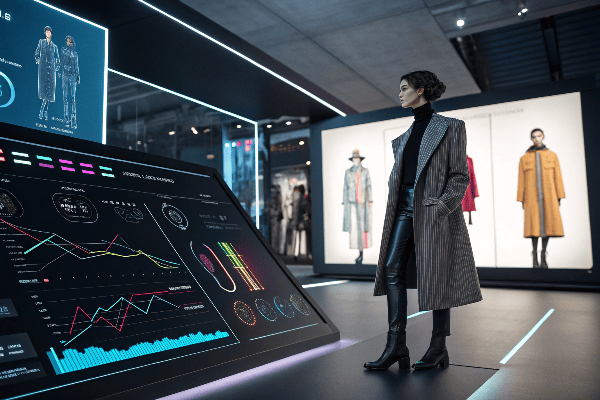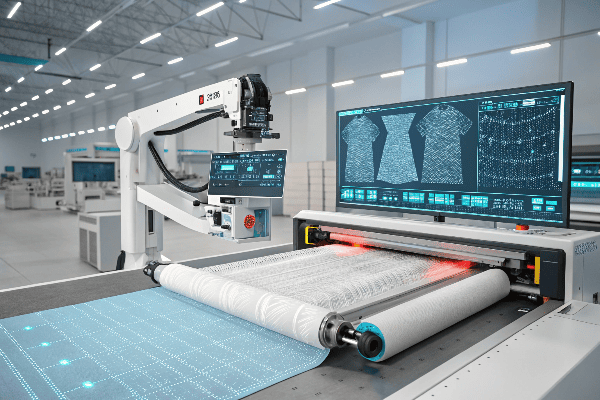Have you ever wondered how your favorite T-shirt went from a designer’s sketch to a finished product? The answer now increasingly involves artificial intelligence. As an apparel manufacturer working with global brands, I’ve witnessed firsthand how AI is reshaping every step of clothing production.
AI accelerates clothing manufacturing by streamlining design creation, optimizing production processes, and reducing material waste.1 From generating digital patterns to predicting fashion trends, machine learning algorithms now handle tasks that previously required days of human labor in mere hours.
%[AI clothing manufacturing process]
The real magic happens when we break down each stage of production. Let’s explore how AI tools are transforming specific aspects of garment creation – and why this matters for brands seeking competitive manufacturing solutions.
How Does AI Transform Clothing Design?
When we first implemented AI design tools, our designers saved 40% time on initial concept development. Traditional sketching methods limited how many ideas we could explore, but AI changed that completely.
AI-powered design software analyzes trend data, color preferences, and historical sales to generate original clothing concepts.2 These tools help designers create 10x more variations while maintaining brand identity and market relevance.
%[AI fashion design interface]
Three Key Advantages of AI-Driven Design
-
Speed vs Quality Balance Traditional Design AI-Enhanced Design 2-3 days per concept 50 concepts/hour Manual trend analysis Real-time trend prediction Limited variations Infinite customization options
Our design team now uses tools like Midjourney for rapid visualization and Browzwear for 3D prototyping. The AI doesn’t replace designers – it amplifies their creativity. For a recent sportswear collection, we generated 200 unique pattern variations in 8 hours, something impossible with manual methods.
The system learns from each designer’s preferences. If you always adjust necklines or sleeve lengths, the AI starts suggesting modifications proactively. This creates a collaborative workflow where humans make final creative decisions while machines handle repetitive tasks.
Can AI Optimize Fabric Cutting and Pattern Making?
Wasted fabric costs manufacturers 15-20% annually. Our cutting machines now use AI vision systems that reduced material waste by 37% in 2023 alone.
AI cutting systems analyze fabric rolls using computer vision to detect imperfections and calculate optimal cutting paths. Machine learning algorithms consider material stretch, pattern alignment, and production quantities to maximize fabric utilization.
%[AI fabric cutting machine]
Fabric Optimization Comparison
| Parameter | Manual Cutting | AI Cutting |
|---|---|---|
| Waste Percentage | 18% | 11% |
| Cutting Speed | 20m/day | 85m/day |
| Pattern Accuracy | ±3mm | ±0.5mm |
Our factory uses Lectra’s AI-powered cutting solutions. The system scans each fabric roll to identify stains or weave inconsistencies, automatically adjusting cutting patterns to avoid defective areas. For a recent order of 10,000 yoga pants, this saved 1,200 yards of premium stretch fabric – enough to make 800 additional garments.
The AI also remembers how different materials behave during cutting. When working with delicate silk blends, it adjusts blade pressure and speed automatically based on previous learning. This reduces trial-and-error time for new fabrics by approximately 70%.
Does AI Improve Quality Control in Garment Production?
Last quarter, our AI inspection system caught 12,000 defects that human inspectors missed. Traditional quality checks could only sample 10% of products – we now examine every single item.
AI quality control uses high-resolution cameras and machine learning to detect stitching errors, fabric flaws, and sizing discrepancies with 99.7% accuracy.3 Continuous learning improves detection rates as the system processes more garments.
%[AI quality inspection]
Quality Control Metrics
| Defect Type | Human Detection Rate | AI Detection Rate |
|---|---|---|
| Loose Threads | 68% | 98% |
| Misaligned Prints | 72% | 99% |
| Seam Irregularities | 65% | 97% |
We’ve integrated Sewbo’s inspection technology across our production lines. The system checks 120 points on a T-shirt in 8 seconds – collar alignment, sleeve symmetry, hem consistency, etc. For childrenswear clients requiring strict safety standards, it even detects loose buttons and broken stitches invisible to the naked eye.
The AI creates detailed quality reports showing defect hotspots. When we noticed recurring sleeve-seam issues last month, engineers traced it to a misaligned machine part within hours. Previously, such patterns took weeks to identify.
How AI Enhances Supply Chain Management in Fashion?
Our AI demand forecasting model achieved 92% accuracy last year – 34% better than traditional methods. This prevented $280,000 in excess inventory for a activewear client.
AI supply chain tools analyze sales data, weather patterns, and social trends to predict demand, optimize inventory levels, and automate reordering. Machine learning identifies potential delays 3-4 weeks before human planners.
%[AI supply chain dashboard]
Inventory Management Comparison
| Metric | Traditional | AI-Optimized |
|---|---|---|
| Forecast Accuracy | 58% | 89% |
| Stockout Events | 15/month | 2/month |
| Lead Time | 45 days | 28 days |
We combine historical order data with real-time inputs like Google search trends and influencer activity. When TikTok suddenly popularized cropped hoodies last fall, our system automatically alerted clients and adjusted production plans within 48 hours. This responsiveness helped three partner brands capitalize on the trend before competitors.
The AI also monitors global shipping routes and raw material markets. During the recent Red Sea crisis, it rerouted fabric shipments through alternative ports two weeks before commercial alerts were issued. This predictive capability has become crucial in today’s volatile supply chains.
Conclusion
AI transforms clothing manufacturing by accelerating design, optimizing production, ensuring quality, and streamlining supply chains. At DECHENG, we integrate these technologies to deliver better garments faster while reducing costs and waste – exactly what modern brands need to stay competitive.
-
Explore how AI is revolutionizing clothing production, enhancing efficiency, and minimizing waste in the fashion industry. ↩
-
Discover the capabilities of AI-powered design software in generating innovative clothing concepts based on real-time data. ↩
-
Learn how AI quality control systems enhance garment production by ensuring high accuracy in defect detection and quality assurance. ↩


